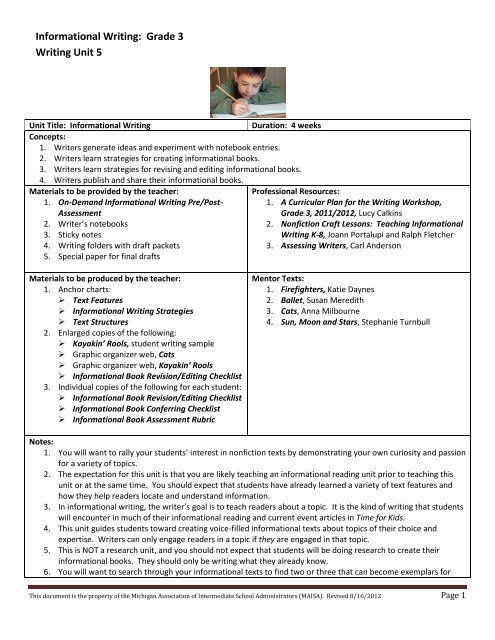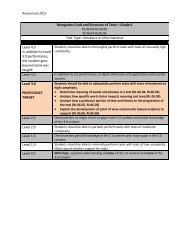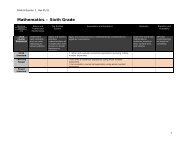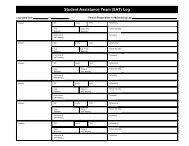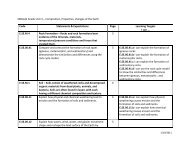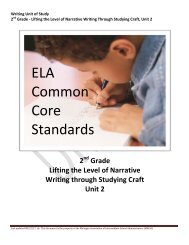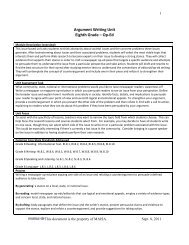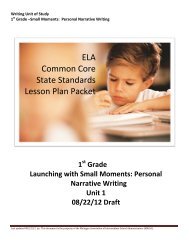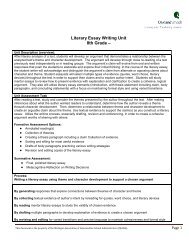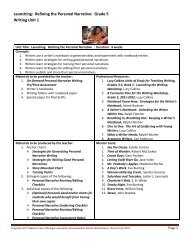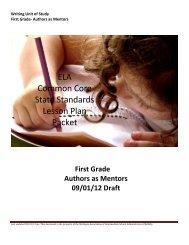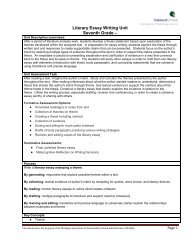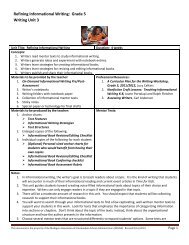Informational Writing Grade 3 Writing Unit 5
Informational Writing: Grade 3 Writing Unit 5
Informational Writing: Grade 3 Writing Unit 5
You also want an ePaper? Increase the reach of your titles
YUMPU automatically turns print PDFs into web optimized ePapers that Google loves.
<strong>Informational</strong> <strong>Writing</strong>: <strong>Grade</strong> 3<strong>Writing</strong> <strong>Unit</strong> 5On-Demand <strong>Informational</strong> <strong>Writing</strong> Pre/Post-AssessmentPre-Assessment Instructions:Students should be at their regular writing seats and will need loose-leaf paper and pencils. They need to be able to addpages if they want.Tell students:“Let’s each write about something we know a lot about – a piece that shows our best work. You will have an hour towrite an informational text like the ones you might see in a student magazine. Here’s what we’ll write about:Think of an animal that you’ve studied or know. You will have an hour to write an informational text thatteaches others interesting and important information and ideas about this animal. Choose an animal that youknow well. Think about informational books and magazines that you have read. Now think about how yourown writing might go. Remember, you are not writing a story. You are writing an informational text aboutan animal that you know a lot about. Write it like you are teaching others about your topic. Use everythingyou know about good writing.”Have students begin their informational writing.Note:This on-demand assessment shows what students know about writing an informational text on a given idea. Score thiswriting using the <strong>Informational</strong> Book Assessment Rubric located at the end of this unit. Pay close attention to whatyour writers can already do and can almost do. This information will help you focus on goals for your students. Use thesame rubric to score their information books at the end of this unit to show what they have learned.Post-Assessment Instructions (optional):At the conclusion of this unit, administer the same on-demand assessment and look for improvements in your students’development as writers.This document is the property of the Michigan Association of Intermediate School Administrators (MAISA). Revised 8/16/2012. Page 5
<strong>Informational</strong> <strong>Writing</strong>: <strong>Grade</strong> 3<strong>Writing</strong> <strong>Unit</strong> 5This document is the property of the Michigan Association of Intermediate School Administrators (MAISA). Revised 8/16/2012. Page 8
<strong>Informational</strong> <strong>Writing</strong>: <strong>Grade</strong> 3<strong>Writing</strong> <strong>Unit</strong> 5This document is the property of the Michigan Association of Intermediate School Administrators (MAISA). Revised 8/16/2012. Page 9
<strong>Informational</strong> <strong>Writing</strong>: <strong>Grade</strong> 3<strong>Writing</strong> <strong>Unit</strong> 5This document is the property of the Michigan Association of Intermediate School Administrators (MAISA). Revised 8/16/2012. Page 10
<strong>Informational</strong> <strong>Writing</strong>: <strong>Grade</strong> 3<strong>Writing</strong> <strong>Unit</strong> 5This document is the property of the Michigan Association of Intermediate School Administrators (MAISA). Revised 8/16/2012. Page 11
<strong>Informational</strong> <strong>Writing</strong>: <strong>Grade</strong> 3<strong>Writing</strong> <strong>Unit</strong> 5This document is the property of the Michigan Association of Intermediate School Administrators (MAISA). Revised 8/16/2012. Page 12
<strong>Informational</strong> <strong>Writing</strong>: <strong>Grade</strong> 3<strong>Writing</strong> <strong>Unit</strong> 5This document is the property of the Michigan Association of Intermediate School Administrators (MAISA). Revised 8/16/2012. Page 13
<strong>Informational</strong> <strong>Writing</strong>: <strong>Grade</strong> 3<strong>Writing</strong> <strong>Unit</strong> 5This document is the property of the Michigan Association of Intermediate School Administrators (MAISA). Revised 8/16/2012. Page 14
<strong>Informational</strong> <strong>Writing</strong>: <strong>Grade</strong> 3<strong>Writing</strong> <strong>Unit</strong> 5ConceptTeaching PointSession 3Writers learn strategies for creating informational books.Writers of informational books use boxes and bullets to organize the information about theirtopics.References• A Curricular Plan for the <strong>Writing</strong>Workshop, <strong>Grade</strong> 3, 2011-2012, LucyCalkinsMaterials• Writer’s notebooks• Cats, Anna Milbourne• Boxes and bullets organizer for Cats• Sticky notesNote • Post on the daily schedule or verbally ask students to bring their writer’s notebooks and apencil to the meeting area.Connection For the past two days, we have been writing about topics that we know a lot about and careabout. Today we are going to organize the information for each topic using boxes and bullets.Demonstration/Teaching• Explain that the author of Cats needed to organize her information to make it easier towrite the book and easier for readers to read it. One way to do this is to use boxes andbullets. Show students an organizer that the author might have used to get started.• Explain that you are going to use boxes and bullets to organize information from your firstentry. Reread your first entry from Session 1 aloud. Write the topic at the top of a pageand put a box around it. Add subtopics, or categories of information, next to bullets asyou think about categories of information you already wrote about in your writer’snotebook. Think of other categories, too, and add those next to bullets.• Explain that using boxes and bullets will help you see if you have enough informationabout each subtopic.ActiveEngagementLink<strong>Writing</strong> andConferringMid-WorkshopTeaching Point• Have students open their notebooks to their first entry and do this same work that youjust demonstrated. Have them:‣ Reread their entry silently.‣ Write the topic on the top of a new page and put a box around it.‣ Have them add two or three subtopics next to bullets as they think about theircategories of information.‣ Turn and share their organizers with their partners.• Show the class one or two student examples of boxes and bullets that are good examples.So writers, today you will finish adding subtopics to your organizers. Include five or six subtopicsfor your topic. When you finish, turn to your next entry and use boxes and bullets to organize theinformation you have for this topic, too.• Conduct individual student conferences to push students to consider additional subtopicsthey can add to their organizers for each topic. They must know something about theseadditional subtopics to include them on their list.• When students have used boxes and bullets to organize both topics, have them choosethe topic they know the most about and make a commitment to write their informationbook about that topic. Distribute small sticky notes for students to mark the topic in theirwriter’s notebooks.• Explain that information writers often make a list of special vocabulary words for theirtopics. Demonstrate this with your own topic by making a list in your writer’s notebook.This document is the property of the Michigan Association of Intermediate School Administrators (MAISA). Revised 8/16/2012. Page 16
<strong>Informational</strong> <strong>Writing</strong>: <strong>Grade</strong> 3<strong>Writing</strong> <strong>Unit</strong> 5• Have students brainstorm a list of special vocabulary words that they think they will use intheir informational books and record them on a new page in their writer’s notebooks.Teaching Share • Bring closure to today’s workshop by summarizing and reinforcing the focus of the day’steaching point. You might have partners share their topics and subtopics or their specialvocabulary words.Boxes and Bullets Organizer for CatsCats• Growing Up• Playing• Climbing• Hunting• Keeping Clean• Cat TalkThis document is the property of the Michigan Association of Intermediate School Administrators (MAISA). Revised 8/16/2012. Page 17
<strong>Informational</strong> <strong>Writing</strong>: <strong>Grade</strong> 3<strong>Writing</strong> <strong>Unit</strong> 5ConceptTeaching PointSession 4Writers learn strategies for creating informational books.Writers of informational books create a Table of Contents.References‣ A Curricular Plan for the <strong>Writing</strong> Workshop,<strong>Grade</strong> 3, 2011-2012, Lucy Calkins‣ Nonfiction Craft Lessons: Teaching<strong>Informational</strong> <strong>Writing</strong> K-8, Joann Portalupiand Ralph FletcherMaterials• Writer’s notebooks• <strong>Writing</strong> folders with draft packets (see notes)• Kayakin’ Rools, Harry Whitfield Rosenbaum• Graphic organizer for Kayakin’ Rools• Anchor chart:‣ Text FeaturesNotes • Post on the daily schedule or verbally ask students to bring their writer’s notebooks and apencil to the meeting area.• Students will continue to use their writer’s notebooks for brainstorming, planning, andearly drafts. Starting today, however, students will use draft packets for drafting theirchapters. Create draft packets for each student by stapling together one title page, oneTable of Contents page, and six sets of subtopic pages (a set includes one page with a textbox and lines, and another page with lines only). After final revisions, students will createfinal drafts of their informational books using special paper.• Today, students will create a Table of Contents based on their web subtopics. However,some adjustments may need to be made in the subtopics during this unit as studentsdiscover whether or not they have enough to say about each one.Connection Yesterday we used boxes and bullets to organize information about our topics. Today we will usethese organizers to create the Table of Contents for our informational books.Demonstration/Teaching• Explain that the author of Kayakin’ Rools might have used boxes and bullets to create hisTable of Contents. Show students the organizer that the author might have used and hisTable of Contents.• Show the students your own draft packet and explain that you will be using a draft packetto write your first draft of your informational books. Write the title and author (yourname) on the cover of your draft packet.• Next, demonstrate how you use the boxes and bullets organizer in your writer’s notebookto create the Table of Contents in your draft packet. Reread each subtopic and decidewhich one should come first. Choose a subtopic that describes a part of your topic forChapter 1.• Think about how you might want to change the wording of your subtopic to make it seemmore interesting as a heading. Write that heading on the first line of your Table ofContents page and explain that this will become Chapter 1.• Explain that headings help you structure, or chunk, your information. They help keep youorganized when you write. Readers appreciate them too, because they know where tofind what they are looking for.• Continue until you have listed all four of your subtopics as headings.• Remind students that all the important words in headings need to begin with capitalletters.• Refer to the anchor chart, Text Features.This document is the property of the Michigan Association of Intermediate School Administrators (MAISA). Revised 8/16/2012. Page 18
<strong>Informational</strong> <strong>Writing</strong>: <strong>Grade</strong> 3<strong>Writing</strong> <strong>Unit</strong> 5ActiveEngagementLink<strong>Writing</strong> andConferring• Distribute a draft packet to each student. Have them write the title and author on thecover. Later, students will have a chance to illustrate the title page.• Have students open their notebooks to their boxes and bullets organizer for the topic theychose for their information book. Have them turn to the second page in their draftpackets and do this same work that you just demonstrated. Remind students to start withthe subtopic that they think should come first, one that describes a part of their topic.Have them think of a way to change the wording of their subtopic to make it aninteresting heading.• Have a few students share their first heading with the class.So writers, remember that a Table of Contents will help you organize your ideas when you writeabout informational topics. Today you will finish creating interesting headings for your Table ofContents from the subtopics on your boxes and bullets organizer. When you finish, get out yourcolored pencils or crayons and make a quick illustration of your topic in the space provided on theTable of Content page.• Conduct individual student conferences to help students complete their Table ofContents.• Encourage students to create interesting headings for their chapter titles.Teaching Share • Bring closure to today’s workshop by summarizing and reinforcing the focus of the day’steaching point. You might share what one or two writers have done in ways that apply toother writers.Text Features• The Table of Contents gives the heading and the beginning page number of each section in abook.• The heading tells what each section is about.This document is the property of the Michigan Association of Intermediate School Administrators (MAISA). Revised 8/16/2012. Page 19
<strong>Informational</strong> <strong>Writing</strong>: <strong>Grade</strong> 3<strong>Writing</strong> <strong>Unit</strong> 5Boxes and Bullets Organizer for Kayakin’ RoolsKayaks• Safety• Kayaks and Canoes• Parts of a Kayak• Kinds of Kayaks• Getting Started• Going PlacesThis document is the property of the Michigan Association of Intermediate School Administrators (MAISA). Revised 8/16/2012. Page 20
<strong>Informational</strong> <strong>Writing</strong>: <strong>Grade</strong> 3<strong>Writing</strong> <strong>Unit</strong> 5Draft Packet(Title)(Illustration)_____________________________________________________(Author)This document is the property of the Michigan Association of Intermediate School Administrators (MAISA). Revised 8/16/2012. Page 21
<strong>Informational</strong> <strong>Writing</strong>: <strong>Grade</strong> 3<strong>Writing</strong> <strong>Unit</strong> 5Table of ContentsPageIntroduction . . . . . . . . . . . . . . . . . . . . . . . . . . . . . . . . . . . . ._____Chapter 1: _______________________________________Chapter 2: _______________________________________Chapter 3: _______________________________________Chapter 4: _______________________________________Conclusion . . . . . . . . . . . . . . . . . . . . . . . . . . . . . . . . . . . . . . . ._____This document is the property of the Michigan Association of Intermediate School Administrators (MAISA). Revised 8/16/2012. Page 22
<strong>Informational</strong> <strong>Writing</strong>: <strong>Grade</strong> 3<strong>Writing</strong> <strong>Unit</strong> 5____________________________________________________(Heading)_____________________________________________(Caption)_________________________________________________________________________________________________________________________________________________________________________________________________________________________________This document is the property of the Michigan Association of Intermediate School Administrators (MAISA). Revised 8/16/2012. Page 23
<strong>Informational</strong> <strong>Writing</strong>: <strong>Grade</strong> 3<strong>Writing</strong> <strong>Unit</strong> 5_________________________________________________________________________________________________________________________________________________________________________________________________________________________________________________________________________________________________________________________________________________________________________________________________________________________________________________________________________________________________________________________________________________________________________________________________________________________________________________________________________________________________________________________________________________________________________________________________________________________________________________________________________________________________________________________________________________________________________________This document is the property of the Michigan Association of Intermediate School Administrators (MAISA). Revised 8/16/2012. Page 24
<strong>Informational</strong> <strong>Writing</strong>: <strong>Grade</strong> 3<strong>Writing</strong> <strong>Unit</strong> 5ConceptTeaching PointSession 5Writers learn strategies for creating informational books.Writers of informational books create introductions for their topics.References• A Curricular Plan for the <strong>Writing</strong>Workshop, <strong>Grade</strong> 3, 2011-2012, LucyCalkins• Nonfiction Craft Lessons: Teaching<strong>Informational</strong> <strong>Writing</strong> K-8, Joann Portalupiand Ralph FletcherMaterials• Writer’s notebooks• <strong>Writing</strong> folders with draft packets• Firefighters, Katie Daynes• Ballet, Susan Meredith• Anchor charts:‣ Text Features‣ <strong>Informational</strong> <strong>Writing</strong> StrategiesConnection Yesterday we created the Table of Contents from our webs. Today we will write introductions tointroduce our topics for our informational books in our draft packets.Demonstration/Teaching• Explain that many informational texts have introductions that explain what the book willbe about. An introduction is the opening sentences of a piece of writing. Think of it asshaking hands with a new person, your reader, for the first time. It’s an important firstconnection. Keep in mind that you are setting up your readers to be experts on yourtopic.• Introductions should do these things:‣ Get your reader interested by asking a question or stating an interesting fact.‣ State one or two big ideas about your topic.• Read aloud and explain the introductions in the texts listed above.• Demonstrate how you think about your own topic and write an introduction on the firstsubtopic page (the first page with a text box and lines) in your draft packet. Write theword Introduction in the space for the heading.• Refer to the anchor charts, <strong>Informational</strong> <strong>Writing</strong> Strategies and Text Features.ActiveEngagement• Have students take a minute or two to think about how they would introduce their topicto their readers.• Have students share their ideas with a partner, and then have one or two students sharewith the class.LinkWriters, remember that the purpose of an introduction is to get your reader interested in yourtopic. Today you will begin writing your own introductions in your draft packets. Think about howthe authors introduced the informational books they wrote. Try at least two different ways ofintroducing your topic, and then decide which one you like best.<strong>Writing</strong> andConferring• Conduct individual student conferences to support students’ efforts at creating theirintroductions.Mid-WorkshopTeaching Point• Have students illustrate their introductions and add a caption that tells a sentence abouttheir illustration. A caption is a sentence, so it needs to be punctuated with a capital letterand ending punctuation.• Refer to the anchor chart, Text Features.Teaching Share • Bring closure to today’s workshop by summarizing and reinforcing the focus of the day’steaching point. You might share what one or two writers have done in ways that apply toother writers.This document is the property of the Michigan Association of Intermediate School Administrators (MAISA). Revised 8/16/2012. Page 25
<strong>Informational</strong> <strong>Writing</strong>: <strong>Grade</strong> 3<strong>Writing</strong> <strong>Unit</strong> 5Text Features• The Table of Contents gives the heading and the beginning page number of each section in abook.• The heading tells what each section is about.• An introduction explains what the book is about.• A caption is a sentence that tells about a picture.<strong>Informational</strong> <strong>Writing</strong> Strategies• The introduction should do these things:‣ Get your reader interested by asking a question or stating an interesting fact.‣ State one or two big ideas about your topic.This document is the property of the Michigan Association of Intermediate School Administrators (MAISA). Revised 8/16/2012. Page 26
<strong>Informational</strong> <strong>Writing</strong>: <strong>Grade</strong> 3<strong>Writing</strong> <strong>Unit</strong> 5ConceptTeaching PointSession 6Writers learn strategies for creating informational books.Writers of informational books use description as they plan to write about their topics.References• A Curricular Plan for the <strong>Writing</strong>Workshop, <strong>Grade</strong> 3, 2011-2012, LucyCalkinsMaterials• Writer’s notebooks• Firefighters, Katie Daynes• Sun, Moon and Stars, Stephanie Turnbull• Anchor charts:‣ Text Features‣ <strong>Informational</strong> <strong>Writing</strong> Strategies‣ Text StructuresNote • Post on the daily schedule or verbally ask students to bring their writer’s notebooks and apencil to the meeting area.• Students will be webbing and creating diagrams in their writer’s notebooks today.Connection Yesterday we created introductions for our informational books. Today we will plan our firstchapter by describing our topic in our writer’s notebooks.Demonstration/TeachingActiveEngagementLink<strong>Writing</strong> andConferringMid-WorkshopTeaching Point• Explain that many informational texts begin by describing something. Your first chapter isgoing to describe your topic.• Refer to the subtopic Safe Clothes on pages 6 and 7 in Firefighters as an example ofdescriptive writing. Notice the special vocabulary words the writer used.• Explain that we are going to make a web to think about ways to describe our topics.• Describe your topic to a student as a way to rehearse for writing about it. List pointsacross your fingers and use an explaining voice.• Remember to use special vocabulary words that might be on your list.• Record your ideas on a web in your writer’s notebook.• Refer to the anchor chart, Text Structures.• Have students take two or three minutes to describe their topics to their partners bylisting points across their fingers and using an explaining voice.• Have students begin to jot these points on a web in their writer’s notebooks by addingone or two points that they described to their partners.So writers, informational writers often use descriptive writing to tell about their topics. Today youwill organize your ideas for writing descriptively by finishing your webs. Add the points you sharedwith your partners. If more points come to your mind, be sure to add them also. Try to use specialvocabulary words in your descriptions.• Conduct table conferences to support students’ efforts at creating their webs.• Explain that when you describe something, you often tell what something looks like or theparts of something. A diagram is a text feature that you can use to show this. The labelsare the words that tell about the parts. Refer to pages 4 and 5 in Sun, Moon and Stars foran example of a diagram. Demonstrate by sketching a diagram in your writer’s notebook.Have students create a diagram of their topic on a new page in their writer’s notebooks.• Refer to the anchor chart, Text Features.Teaching Share • Bring closure to today’s workshop by summarizing and reinforcing the focus of the day’sThis document is the property of the Michigan Association of Intermediate School Administrators (MAISA). Revised 8/16/2012. Page 27
<strong>Informational</strong> <strong>Writing</strong>: <strong>Grade</strong> 3<strong>Writing</strong> <strong>Unit</strong> 5teaching point. You might share what one or two writers have done in ways that apply toother writers.Text Features• The Table of Contents gives the heading and the beginning page number of each section in abook.• The heading tells what each section is about.• An introduction explains what the book is about.• A caption is a sentence that tells about a picture.• A diagram is a labeled picture that shows the parts of something.• A label is a word that tells about a picture.<strong>Informational</strong> <strong>Writing</strong> Strategies• The introduction should do these things:‣ Get your reader interested by asking a question or stating an interesting fact.‣ State one or two big ideas about your topic.Text Structures• Description – The author describes the topic by giving details about how it looks or how itworks.WebThis document is the property of the Michigan Association of Intermediate School Administrators (MAISA). Revised 8/16/2012. Page 28
<strong>Informational</strong> <strong>Writing</strong>: <strong>Grade</strong> 3<strong>Writing</strong> <strong>Unit</strong> 5ConceptTeaching PointSession 7Writers learn strategies for creating informational books.Writers of informational books use description to draft their topics.References• A Curricular Plan for the <strong>Writing</strong>Workshop, <strong>Grade</strong> 3, 2011-2012, LucyCalkinsMaterials• Writer’s notebooks• <strong>Writing</strong> folders with draft packets• Cats, Anna Milbourne• Anchor charts:‣ Text Features‣ <strong>Informational</strong> <strong>Writing</strong> Strategies‣ Text StructuresNotes • Post on the daily schedule or verbally ask students to bring their writer’s notebooks to themeeting area.• Students will be drafting their descriptions in their draft packets today.Connection Yesterday we created webs and diagrams in our writer’s notebooks to plan our drafts for ourinformational books. Today we will draft this chapter using headings and labeled diagrams in ourdraft packets.Demonstration/TeachingActiveEngagementLink• Explain that information writers help their readers picture what they are writing about.They take time to write descriptions that help readers make a mind picture of the topic.• Read aloud Cats pages 26 and 27. Have students notice how the writer used the heading,Fur, from the Table of Contents. The writer began with a topic sentence, one that tells abig idea about this subtopic, and then added the details.• Demonstrate how you write about your topic on the next page of your draft packet (apage with a text box) using ideas from your web. Write in a way that will interest yourreader. Use either second person (You will need to wear …) or third person (Soccerplayers wear …), but not first person (I always wear my helmet …) as you write.• Begin with a topic sentence that tells a big idea about your subtopic. Use specialvocabulary words from your list. Then describe your topic by adding details that createsensory images (things you see, hear, feel, smell, and taste) in the mind of the reader.• Refer to the anchor chart, <strong>Informational</strong> <strong>Writing</strong> Strategies and Text Structures.• Have students open their notebooks to their webs and do this same work that you justdemonstrated. Have them:‣ Think about a topic sentence they would use to begin.‣ Think about how they might describe their topic using sensory details.‣ Share their ideas with their partners.• Have one or two students share with the class.So writers, you will be drafting your first subtopic in your draft packets today using description.Remember to start with a topic sentence. Then add sensory details to create a mind picture foryour reader. Create a labeled diagram in the space provided, just like the one you sketchedyesterday in your writer’s notebooks.• Conduct table conferences to support students’ efforts at drafting using topic sentencesand sensory details and creating their diagrams.<strong>Writing</strong> andConferringMid-Workshop • Locate a place in your own writing where you used a special vocabulary word, or a placeThis document is the property of the Michigan Association of Intermediate School Administrators (MAISA). Revised 8/16/2012. Page 29
<strong>Informational</strong> <strong>Writing</strong>: <strong>Grade</strong> 3<strong>Writing</strong> <strong>Unit</strong> 5Teaching Pointwhere you used an ordinary word, but you could have used a special vocabulary word.• Demonstrate two ways to define a special vocabulary word by referring to the followingexamples on pages 26 and 28 in Cats:‣ Define the word in the same sentence in which it is used:Different kinds of cats are called breeds.‣ Define the word in the next sentence:In summer, some of a cat’s fur falls out, so the cat doesn’t get too hot. This is calledshedding.• Explain that special vocabulary words are often, but not always, in bold print.• Have students define one or more of their words using one of these examples.• Refer to the anchor chart, Text Features.Teaching Share • Bring closure to today’s workshop by summarizing and reinforcing the focus of the day’steaching point. You might share what one or two writers have done in ways that apply toother writers.This document is the property of the Michigan Association of Intermediate School Administrators (MAISA). Revised 8/16/2012. Page 30
<strong>Informational</strong> <strong>Writing</strong>: <strong>Grade</strong> 3<strong>Writing</strong> <strong>Unit</strong> 5Text Features• The Table of Contents gives the heading and the beginning page number of each section in abook.• The heading tells what each section is about.• An introduction explains what the book is about.• A caption is a sentence that tells about a picture.• A diagram is a labeled picture that shows the parts of something.• A label is a word that tells about a picture.• Bold print shows new or important words.<strong>Informational</strong> <strong>Writing</strong> Strategies• The introduction should do these things:‣ Get your reader interested by asking a question or stating an interesting fact.‣ State one or two big ideas about your topic.• Use sensory details to describe your topic.Text Structures• Description – The author describes the topic by giving details about how it looks or how itworks.WebThis document is the property of the Michigan Association of Intermediate School Administrators (MAISA). Revised 8/16/2012. Page 31
<strong>Informational</strong> <strong>Writing</strong>: <strong>Grade</strong> 3<strong>Writing</strong> <strong>Unit</strong> 5ConceptTeaching PointSession 8Writers learn strategies for creating informational books.Writers of informational texts elaborate by writing partner sentences.References• A Curricular Plan for the <strong>Writing</strong>Workshop, <strong>Grade</strong> 3, 2011-2012, LucyCalkinsMaterials• <strong>Writing</strong> folders with draft packets• Cats, Anna Milbourne• Anchor charts:‣ Text Features‣ <strong>Informational</strong> <strong>Writing</strong> Strategies‣ Text StructuresNotes • Post on the daily schedule or verbally ask students to bring their draft packets and a pencilto the meeting area.• Students will be elaborating on their drafts from Session 7 today.Connection Yesterday, we drafted our first chapter using description. Today, we will elaborate by writingpartner sentences to tell more about our topics in our draft packets.Demonstration/TeachingActiveEngagementLink<strong>Writing</strong> andConferringMid-WorkshopTeaching Point• Explain that one way to elaborate is to write partner sentences.• You could choose any sentence in your writing and create a partner sentence, or secondsentence. A partner sentence can be added to describe something in the first sentence, toexplain something, or to give a reason or example:‣ Sometimes the second sentence describes something (page 26):This kind of cat is called a Persian cat. They have very long fur.‣ Sometimes the second sentence explains something (page 25):A cat’s tongue is very rough. When a cat licks its fur, its tongue works like a comb.‣ Sometimes the second sentence gives a reason or example (page 10):You can tell how a cat feels by the way it looks and acts. If a cat rolls onto its back,then it feels safe with you.• Demonstrate by rereading a sentence that you wrote yesterday. Think about what elseyou could say about that idea. Write a partner sentence that tells more about the firstone. Use a caret to add the sentence between the lines (if there is room) or a numberedinsert to add the sentence on a separate page.• Refer to the anchor chart, <strong>Informational</strong> <strong>Writing</strong> Strategies.• Have students reread a sentence from their draft packet and think of a partner sentencethey can add to tell more. Have them share their partner sentences with their partners.• Have one or two students share with the class.Writers, one way that writers elaborate is to write partner sentences. Today reread each sentencein chapter 1 and write a partner sentence that you can add to tell more about each sentence.Remember, you can describe, explain, give a reason, or give an example. Writers use partnersentences whenever they do any kind of writing.• Conduct table conferences to support students’ use of partner sentences.Remember that writers don’t just teach information with words, they teach information withdiagrams and illustrations that might help the reader understand. Look though some of yourinformational texts to get some tips on how to create diagrams and illustrations. Then think aboutways in which you might want to use diagrams and illustrations in your informational books.This document is the property of the Michigan Association of Intermediate School Administrators (MAISA). Revised 8/16/2012. Page 32
33stop the spread of germs and infectious diseases. Similarly, low-flow showerheadsshould also be considered, as much more water is wasted in showers. These low-flowshowerheads reduce the gallons used per minute to 2.5 gallons or less.These simple building solutions are already implemented in campus buildings suchas the Dana Science Building, the Chemistry Building, and the Shapiro UndergraduateLibrary. The bathrooms in these buildings do not see as many people per day as mostdorms. Specifically, these bathrooms are not used by 1180 students multiple times perday, as the bathrooms in Mark Markley Hall are. In addition to using toilets and washinghands, students in dorms also take showers and brush their teeth. So installing faucetaerators and dual-flush toilet valves would significantly reduce water usage, safe theuniversity money, and lessen the effect of water waste on the environment.This issue is especially pressing because when the University of Michiganremodeled Mosher-Jordan Residence Hall, it had a great opportunity to add these newfaucets and toilet flush valves. But these cost and environment-saving measures werenot taken. Figures 4, 5, and 6 (below) show the faucets and toilet flushes that wereinstalled during the renovation—standard faucets and toilet flushers--which makes itsafe to assume that the university will not install faucet aerators and dual-flush toiletvalves in future Residence Hall renovations. The University of Michigan published anEnergy and Water Conservation document that included the projects that would beincorporated in new buildings across campus. The water conservation projects includethe following: dual flush water closets, ½ gpm aerators for lavatory faucets, and 2 gpmThis document is the property of MAISA. Sept. 8, 2011
<strong>Informational</strong> <strong>Writing</strong>: <strong>Grade</strong> 3<strong>Writing</strong> <strong>Unit</strong> 5Text Structures• Description – The author describes the topic by giving details about how it looks or how itworks.Web• Sequence – The author gives information in the order it happens.Flow DiagramTimelineThis document is the property of the Michigan Association of Intermediate School Administrators (MAISA). Revised 8/16/2012. Page 36
<strong>Informational</strong> <strong>Writing</strong>: <strong>Grade</strong> 3<strong>Writing</strong> <strong>Unit</strong> 5Mid-WorkshopTeaching Point• Share the writing of one or two students who have used sequence with transition wordseffectively in their writing with the class.Teaching Share • Bring closure to today’s workshop by summarizing and reinforcing the focus of the day’steaching point. You might share what one or two writers have done in ways that apply toother writers.Text Features• The Table of Contents gives the heading and the beginning page number of each section in abook.• The heading tells what each section is about.• An introduction explains what the book is about.• A caption is a sentence that tells about a picture.• A diagram is a labeled picture that shows the parts of something.• A label is a word that tells about a picture.• Bold print shows new or important words.• A flow diagram is a diagram that shows sequence.• A timeline is a chart that shows events in order.<strong>Informational</strong> <strong>Writing</strong> Strategies• The introduction should do these things:‣ Get your reader interested by asking a question or stating an interesting fact.‣ State one or two big ideas about your topic.• Use sensory details to describe your topic.• Write partner sentences by describing, explaining, giving a reason, or giving an example.• Use transition words to show sequence (first, after, then, next, afterward, finally).This document is the property of the Michigan Association of Intermediate School Administrators (MAISA). Revised 8/16/2012. Page 38
<strong>Informational</strong> <strong>Writing</strong>: <strong>Grade</strong> 3<strong>Writing</strong> <strong>Unit</strong> 5ConceptTeaching PointSession 11Writers learn strategies for creating informational books.Writers of informational texts use comparison as they plan their topics.References• A Curricular Plan for the <strong>Writing</strong>Workshop, <strong>Grade</strong> 3, 2011-2012, LucyCalkinsMaterials• Writer’s notebooks• Cats, Anna Milbourne• Anchor charts:‣ Text Features‣ <strong>Informational</strong> <strong>Writing</strong> Strategies‣ Text StructuresNotes • Post on the daily schedule or verbally ask students to bring their writer’s notebooks and apencil to the meeting area.• Students will be using Venn diagrams or T-charts to make comparisons in their writer’snotebooks today. Some students will begin drafting their comparison chapter in theirwriter’s notebooks, too.Connection Yesterday we drafter our sequence chapters for our informational books. Today we will usecomparison to plan a chapter for our books in our writer’s notebooks.Demonstration/TeachingActiveEngagementLink<strong>Writing</strong> andConferring• Explain that many informational texts use comparison to tell about the topic. One of yourchapters possibly fits this structure.• Refer to Cats on page 20. The author compares a cat’s pupil in bright light and in dimlight. Also, on page 22, the author compares how a cat sleeps when it’s hot, and how acat sleeps when it’s cool.• Demonstrate how you look through your Table of Contents to locate a chapter that can bewritten using a comparison structure. Think aloud how you can compare two kinds, parts,or examples of something related to your topic.• Explain that when you compare something, you show how two things are alike and/ordifferent. This information can be recorded on a Venn diagram or T-chart (list the twothings being compared at the top of the chart and list parallel ideas, whether they arealike or different, in the space below).• Demonstrate how to record your ideas on a Venn diagram or T-chart on a new page inyour writer’s notebook.• Refer to the anchor chart Text Structures.Note: If students do not have a subtopic that follows a comparison structure, have them writeanother chapter using description or sequence.• Have students look through their Table of Contents to locate a chapter that can be writtenusing a comparison structure.• Have students explain their comparisons to their partners.Writers, remember that sometimes informational texts are organized by making comparisons.Today you will create a Venn diagram or T-chart by listing the similarities and/or differences aboutyour topic. If one of your subtopics does not follow a comparison structure, then write the chapterusing description or sequence.• Conduct table conferences to support students’ efforts at creating their Venn diagramsand T-charts.This document is the property of the Michigan Association of Intermediate School Administrators (MAISA). Revised 8/16/2012. Page 39
<strong>Informational</strong> <strong>Writing</strong>: <strong>Grade</strong> 3<strong>Writing</strong> <strong>Unit</strong> 5Mid-WorkshopTeaching Point• Demonstrate how you illustrate the two things you are comparing in your writer’snotebook, making sure to highlight the similarities and/or differences. Have students dothis same work in their own writer’s notebooks.Teaching Share • Bring closure to today’s workshop by summarizing and reinforcing the focus of the day’steaching point. You might share what one or two writers have done in ways that apply toother writers or have partners share their comparisons.Text Features• The Table of Contents gives the heading and the beginning page number of each section in abook.• The heading tells what each section is about.• An introduction explains what the book is about.• A caption is a sentence that tells about a picture.• A diagram is a labeled picture that shows the parts of something.• A label is a word that tells about a picture.• Bold print shows new or important words.• A flow diagram is a diagram that shows sequence.• A timeline is a chart that shows events in order.<strong>Informational</strong> <strong>Writing</strong> Strategies• The introduction should do these things:‣ Get your reader interested by asking a question or stating an interesting fact.‣ State one or two big ideas about your topic.• Use sensory details to describe your topic.• Write partner sentences by describing, explaining, or giving a reason or example.• Use transition words to show sequence (first, after, then, next, afterward, finally).This document is the property of the Michigan Association of Intermediate School Administrators (MAISA). Revised 8/16/2012. Page 40
<strong>Informational</strong> <strong>Writing</strong>: <strong>Grade</strong> 3<strong>Writing</strong> <strong>Unit</strong> 5Text Structures• Description – The author describes the topic by giving details about how it looks or how itworks.Web• Sequence – The author gives information in the order it happens.Flow DiagramTimeline• Comparison – The author tells how two things are alike and how they are different.Venn DiagramT-ChartThis document is the property of the Michigan Association of Intermediate School Administrators (MAISA). Revised 8/16/2012. Page 41
<strong>Informational</strong> <strong>Writing</strong>: <strong>Grade</strong> 3<strong>Writing</strong> <strong>Unit</strong> 5ConceptTeaching PointSession 12Writers learn strategies for creating informational books.Writers of informational texts use comparison to write about their topics.References• A Curricular Plan for the <strong>Writing</strong>Workshop, <strong>Grade</strong> 3, 2011-2012, LucyCalkinsMaterials• Writer’s notebooks• <strong>Writing</strong> folders with draft packets• Firefighters, Katie Daynes• Kayakin’ Rools, Harry Whitfield Rosenbaum• Anchor charts:‣ Text Features‣ <strong>Informational</strong> <strong>Writing</strong> Strategies‣ Text StructuresNote • Post on the daily schedule or verbally ask students to bring their writer’s notebooks and apencil to the meeting area.• Students will be drafting their comparison chapters in their draft packets today.Connection Yesterday some of us created Venn diagrams and T-charts to plan our drafts for our informationalbooks. Today we will use our comparisons, or other text structures, to write the third chapter forour books in our draft packets.Demonstration/TeachingActiveEngagementLink• Explain that information writers help their readers understand their topic by usingcomparisons. They write parallel sentences, (refer to page 17 of Firefighters):‣ At a small fire, firefighters attach a hose to the fire engine and use water from itstank.‣ At a big fire, they find a fire hydrant and use water from pipes under the ground.• Information writers also create parallel drawings to teach their readers about their topics.• Share pages 3 and 5 in Kayakin’ Rools. Ask students to notice how the author comparedtwo things by using parallel sentences and parallel drawings.• Demonstrate how you use the information in your Venn diagram or T-chart to make acomparison about your topic using parallel sentences. Then write about your topic on thenext page of your draft packet using parallel sentences.• Refer to the anchor chart <strong>Informational</strong> <strong>Writing</strong> Strategies.• Have students take two or three minutes to compare two things about their topics usingparallel sentences with their partners.• Have one or two students share with the class.Writers, you will be drafting your last subtopic in your draft packets today using comparison or oneof the other text structures to organize your writing. Remember to use parallel sentences andparallel drawings to teach your readers about your topics. You might want to divide the space intwo parts for your parallel drawings.• Conduct table conferences to support students’ efforts at drafting and illustrating theirtopics using parallel sentences and parallel drawings.• Share the comparisons made by one or two students who have used parallel sentencesand parallel drawings effectively in their writing with the class.<strong>Writing</strong> andConferringMid-WorkshopTeaching PointTeaching Share • Bring closure to today’s workshop by summarizing and reinforcing the focus of the day’steaching point. You might share what one or two writers have done in ways that apply toThis document is the property of the Michigan Association of Intermediate School Administrators (MAISA). Revised 8/16/2012. Page 42
<strong>Informational</strong> <strong>Writing</strong>: <strong>Grade</strong> 3<strong>Writing</strong> <strong>Unit</strong> 5other writers.Text Features• The Table of Contents gives the heading and the beginning page number of each section in abook.• The heading tells what each section is about.• An introduction explains what the book is about.• A caption is a sentence that tells about a picture.• A diagram is a labeled picture that shows the parts of something.• A label is a word that tells about a picture.• Bold print shows new or important words.• A flow diagram is a diagram that shows sequence.• A timeline is a chart that shows events in order.<strong>Informational</strong> <strong>Writing</strong> Strategies• The introduction should do these things:‣ Get your reader interested by asking a question or stating an interesting fact.‣ State one or two big ideas about your topic.• Use sensory details to describe your topic.• Write partner sentences by describing, explaining, or giving a reason or example.• Use transition words to show sequence (first, after, then, next, afterward, finally).• Use parallel sentences and parallel drawings to compare two things.This document is the property of the Michigan Association of Intermediate School Administrators (MAISA). Revised 8/16/2012. Page 43
<strong>Informational</strong> <strong>Writing</strong>: <strong>Grade</strong> 3<strong>Writing</strong> <strong>Unit</strong> 5ConceptTeaching PointSession 13Writers learn strategies for creating informational books.Writers of informational texts choose the best way to organize their ideas.References• A Curricular Plan for the <strong>Writing</strong>Workshop, <strong>Grade</strong> 3, 2011-2012, LucyCalkinsMaterials• Writer’s notebooks• <strong>Writing</strong> folders with draft packets• Anchor chart:‣ Text Structures‣ Text FeaturesNotes • Plan to spend two days on this session having students plan the first day and write thesecond day.• Post on the daily schedule or verbally ask students to bring their writer’s notebooks and apencil to the meeting area.Connection Yesterday, many of us drafted a chapter using a comparison text structure. Today we will write achapter about the remaining subtopic in our draft packets. We will decide the best way to organizeour ideas by choosing which text structure best fits our subtopics.Demonstration/TeachingActiveEngagementLink<strong>Writing</strong> andConferringMid-Workshop• Demonstrate how you read the remaining subtopics on your own Table of Contents anddecide which one you will write about today.• Think aloud all you know about the subtopic. Then choose the best text structure fororganizing this information – description, sequence, or comparison - and explain why.• Refer to the anchor chart, Text Structures.• You have two options starting today:‣ Plan in your writer’s notebook. Draw an organizer that fits with the text structure inyour writer’s notebook and record information about your subtopic OR,‣ Plan in your draft packet. Tell about this subtopic across your fingers. Divide thesubtopic into two, three, or four parts (kinds, ways, examples), and then plan thischapter by illustrating it first in the space provided on the next page of your draftpacket. You might divide the box for illustrations into two, three, or four sections.• Start with a sentence that tells the readers what they will be learning about. Then adddetails that support the big idea. Make sure that each detail fits with the subtopic.Remember to use special vocabulary words.• Refer to the anchor chart, <strong>Informational</strong> <strong>Writing</strong> Strategies.• Have students take two or three minutes to choose their next topic from their Table ofContents. Have them choose the best text structure for organizing this information –description, sequence, or comparison – and explain why. Have them share with theirpartners.• Have one or two students share with the class.Writers, today and every day that you write informational texts, be sure that you are choosing thebest way to organize the information. Start with a sentence that tells the readers what they willbe reading about. Then add details that support the big idea.• Conduct table conferences to support students’ efforts at choosing the best way toorganize their information and using topic sentences and details.Remember that writers don’t just teach information with words, they teach information withThis document is the property of the Michigan Association of Intermediate School Administrators (MAISA). Revised 8/16/2012. Page 44
<strong>Informational</strong> <strong>Writing</strong>: <strong>Grade</strong> 3<strong>Writing</strong> <strong>Unit</strong> 5Teaching Point illustrations, diagrams, and other tools. Look through some of your informational texts to getsome tips on how to create these text features. Refer to the anchor chart, Text Features.Teaching Share • Bring closure to today’s workshop by summarizing and reinforcing the focus of the day’steaching point. You might share what one or two writers have done in ways that apply toother writers or have partners share their writing and explain why they used a particulartext structure.Text Features• The Table of Contents gives the heading and the beginning page number of each section in abook.• The heading tells what each section is about.• An introduction explains what the book is about.• A caption is a sentence that tells about a picture.• A diagram is a labeled picture that shows the parts of something.• A label is a word that tells about a picture.• Bold print shows new or important words.• A flow diagram is a diagram that shows sequence.• A timeline is a chart that shows events in order.<strong>Informational</strong> <strong>Writing</strong> Strategies• The introduction should do these things:‣ Get your reader interested by asking a question or stating an interesting fact.‣ State one or two big ideas about your topic.• Use sensory details to describe your topic.• Write partner sentences by describing, explaining, or giving a reason or example.• Use transition words to show sequence (first, after, then, next, afterward, finally).• Use parallel sentences and parallel drawings to compare two things.This document is the property of the Michigan Association of Intermediate School Administrators (MAISA). Revised 8/16/2012. Page 45
<strong>Informational</strong> <strong>Writing</strong>: <strong>Grade</strong> 3<strong>Writing</strong> <strong>Unit</strong> 5Text Structures• Description – The author describes the topic by giving details about how it looks or how itworks.Web• Sequence – The author gives information in the order it happens.Flow DiagramTimeline• Comparison – The author tells how two things are alike and how they are different.Venn DiagramT-ChartThis document is the property of the Michigan Association of Intermediate School Administrators (MAISA). Revised 8/16/2012. Page 46
<strong>Informational</strong> <strong>Writing</strong>: <strong>Grade</strong> 3<strong>Writing</strong> <strong>Unit</strong> 5ConceptTeaching PointSession 14 (optional)Writers learn strategies for creating informational books.Writers of informational texts choose the best way to organize their ideas.References• A Curricular Plan for the <strong>Writing</strong>Workshop, <strong>Grade</strong> 3, 2011-2012, LucyCalkinsMaterials• Writer’s notebooks• <strong>Writing</strong> folders with draft packets• Anchor chart:‣ Text Structures‣ Text FeaturesNotes • Some students may need more time to finish their four chapters. Others may want toinclude one or two additional chapters. Follow the format in this session if your studentsneed more time.• Post on the daily schedule or verbally ask students to bring their writer’s notebooks and apencil to the meeting area.Connection Yesterday, we drafted a chapter using a comparison structure. Today we will continue to work onwriting our chapters in our draft packets. Some of us are still working on our four chapters. Someof us may want to include one more chapter in our informational books. When we add morechapters, we will decide the best way to organize our ideas by choosing which text structure bestfits our subtopics.Demonstration/TeachingActiveEngagementLink<strong>Writing</strong> andConferringMid-WorkshopTeaching Point• Demonstrate how you decide to include another chapter in your informational book. Addthe heading to your Table of Contents and plan how you are going to organize theinformation.• Think aloud all you know about the subtopic. Then choose the best text structure fororganizing this information and explain why.• Refer to the anchor chart, Text Structures.• Draw an organizer that fits with the text structure (web, flow diagram, timeline, Venndiagram, T-chart) in your writer’s notebook and record information about your subtopic.• Start with a sentence that tells the readers what they will be learning about. Then adddetails that support the big idea. Make sure that each detail fits with the subtopic.Remember to use special vocabulary words.• Refer to the anchor chart, <strong>Informational</strong> <strong>Writing</strong> Strategies.• Have students plan their work for the day. They will either finish a previous chapter orbegin work on a new one.• Have students share their plans with their partners.• Have one or two students share with the class.Writers, today and every day that you write informational texts, be sure that you are choosing thebest way to organize the information. Start with a sentence that tells the readers what they willbe reading about. Then add details that support the big idea.• Conduct table conferences to support students’ efforts at choosing the best way toorganize their information and using topic sentences and details.Remember that writers don’t just teach information with words, they teach information withillustrations, diagrams, and other tools. Look through some of your informational texts to getsome tips on how to create these text features. Refer to the anchor chart, Text Features.This document is the property of the Michigan Association of Intermediate School Administrators (MAISA). Revised 8/16/2012. Page 47
<strong>Informational</strong> <strong>Writing</strong>: <strong>Grade</strong> 3<strong>Writing</strong> <strong>Unit</strong> 5Teaching Share • Bring closure to today’s workshop by summarizing and reinforcing the focus of the day’steaching point. You might share what a few writers have done in ways that apply to otherwriters or have partners share their writing and explain why they used a particular textstructure.This document is the property of the Michigan Association of Intermediate School Administrators (MAISA). Revised 8/16/2012. Page 48
<strong>Informational</strong> <strong>Writing</strong>: <strong>Grade</strong> 3<strong>Writing</strong> <strong>Unit</strong> 5ConceptTeaching PointSession 15Writers learn strategies for creating informational books.Writers of informational books create conclusions for their topics.References• A Curricular Plan for the <strong>Writing</strong>Workshop, <strong>Grade</strong> 3, 2011-2012, LucyCalkinsMaterials• Writer’s notebooks• <strong>Writing</strong> folders with draft packets• Anchor chart:‣ <strong>Informational</strong> <strong>Writing</strong> StrategiesNotes • Post on the daily schedule or verbally ask students to bring their draft packets and a pencilto the meeting area.• Students will be drafting their concluding statements in their draft packets.Connection Yesterday, we drafted the last chapter for our informational books. Today, we will draft ourconcluding statements in our draft packets, leaving readers with a big idea about our topics.Demonstration/TeachingActiveEngagementLink• Demonstrate how to write a concluding statement that tells why your topic matters toyou and then invite others to take an interest. Follow the framework below:• Sentence one:‣ (My topic) is the best because …‣ (My topic) is interesting because …‣ (My topic) is fun because ….‣ One thing I know for sure is that …• Sentence two:‣ You might want to …‣ Maybe you will try …‣ Why don’t you …‣ Maybe someday you will want to …• Refer to the anchor chart, <strong>Informational</strong> <strong>Writing</strong> Strategies.• Have students refer to the anchor chart and create a concluding statement for theirinformational books.• Have them share their ideas with their partners.• Have one or two students share with the class.Writers, today you will write your concluding statements in your draft packets. When you aredone, look through your draft packets to make sure that you have completed every page. Youshould have included clearly written text and text features that help the reader understand everysubtopic.• Conduct table conferences to support students’ efforts at writing their concludingstatements and completing their draft packets.<strong>Writing</strong> andConferringTeaching Share • Bring closure to today’s workshop by summarizing and reinforcing the focus of the day’steaching point. You might share what a few writers have done in ways that apply to otherwriters.This document is the property of the Michigan Association of Intermediate School Administrators (MAISA). Revised 8/16/2012. Page 49
<strong>Informational</strong> <strong>Writing</strong>: <strong>Grade</strong> 3<strong>Writing</strong> <strong>Unit</strong> 5<strong>Informational</strong> <strong>Writing</strong> Strategies• The introduction should do these things:‣ Get your reader interested by asking a question or stating an interesting fact.‣ State one or two big ideas about your topic• Use sensory details to describe your topic.• Write partner sentences by describing, explaining, or giving a reason or example.• Use transition words to show sequence (first, after, then, next, afterward, finally).• Use parallel sentences and parallel drawings to compare two things.• The concluding statement leaves the reader with a big idea about the topic.This document is the property of the Michigan Association of Intermediate School Administrators (MAISA). Revised 8/16/2012. Page 50
<strong>Informational</strong> <strong>Writing</strong>: <strong>Grade</strong> 3<strong>Writing</strong> <strong>Unit</strong> 5ConceptTeaching PointSession 16Writers learn strategies for revising and editing their informational books.Writers use revision/editing checklists to revise and edit their writing.References• A Curricular Plan for the <strong>Writing</strong>Workshop, <strong>Grade</strong> 3, 2011-2012, LucyCalkinsMaterials• <strong>Writing</strong> folders• <strong>Informational</strong> Book Revision/Editing Checklist foreach student• Chart-sized <strong>Informational</strong> Book Revision/EditingChecklistNotes • Put an <strong>Informational</strong> Book Revision/Editing Checklist inside each student’s writing folder.• You might need to spend two days on this lesson. Make sure that students are trulyrevising and editing each item on the checklist.Connection Yesterday, we completed the drafts for our informational books. Today, we will learn thatinformation writers edit carefully, making sure that their writing is accurate so readers canunderstand the information.Demonstration/TeachingActiveEngagementLink<strong>Writing</strong> andConferringMid-WorkshopTeaching PointNote• Demonstrate how to use an item on the checklist as a lens by rereading your owninformational book through that lens.‣ Read the first item on the checklist (Will this make sense to a stranger?)‣ Pretend you know nothing about the topic. Read and mark places that are confusing.‣ Go back and rewrite those parts so they are clearer.• Read your writing one chapter at a time through the lens of each item on the checklist.Mark notations such as I (for Introduction), 1, 2, 3, 4 (for each chapter), and C (forconclusion) in the Author column of the checklist as you revise and edit each item.• Continue reading your informational book through each lens and then edit your story withthe students’ input.• Never assume that just because a word wall or word chart is available, your students willautomatically use it. Teach students explicitly that when they use the word wall, theyneed to look at the whole word, make a picture of it in their minds, and then write theentire word as best they can without peeking. They should not copy it one letter at atime. Words are learned by practicing the whole word.So writers, always remember that whenever you are going to publish your writing, you need to editit very carefully so that the people reading it will understand your meaning. Find theRevision/Editing Checklist in your writing folders and use each item as a lens when you revise oredit your work. This is the time to get your writing as polished as you can get it.• Conduct table conferences to support students’ efforts using the checklist to makerevisions and to check the spelling of special vocabulary words.• Help students with the spelling of their special vocabulary words. You might:‣ Have students refer to an informational text that includes the special vocabularywords.‣ Have students use a spelling dictionary or student dictionary to locate the words.‣ Spell the words for the students or help them spell them.Say, Tonight I’m going to look over the drafts that you’ve edited today and be your copy editor.Tomorrow, every minute of the day will be reserved for making final copies of our stories.This document is the property of the Michigan Association of Intermediate School Administrators (MAISA). Revised 8/16/2012. Page 51
<strong>Informational</strong> <strong>Writing</strong>: <strong>Grade</strong> 3<strong>Writing</strong> <strong>Unit</strong> 5<strong>Informational</strong> Book Revision/Editing ChecklistName_______________________________________________Date______________Title_________________________________________________________________Reread your writing carefully.Put a check in each box under Author as you complete each item.Then give this checklist to the teacher for the final edit.Revise and edit for the following: Author Teacher1. Clarity and Meaning. Ask yourself,“Will this make sense to a stranger?”“Is my writing clear?”Rewrite parts that need revision.2. Important Ideas and Details. Ask yourself,“Do the details support the important ideas?”“Did I use partner sentences?”“What should I add?”Rewrite parts that need revision.3. Capital Letters.Use capital letters at the beginning of sentences, headings, andproper names.Make corrections.4. Ending punctuation.Use periods, exclamation points, and question marks.Make corrections.5. Spelling.Check a chart or Word Wall.Use a dictionary or other book.Make corrections.This document is the property of the Michigan Association of Intermediate School Administrators (MAISA). Revised 8/16/2012. Page 52
<strong>Informational</strong> <strong>Writing</strong>: <strong>Grade</strong> 3<strong>Writing</strong> <strong>Unit</strong> 5ConceptTeaching PointSessions 17 and 18Writers publish and share their informational books.A writing community celebrates.References• Assessing Writers, Carl Anderson• A Curricular Plan for the <strong>Writing</strong>Workshop, <strong>Grade</strong> 3, 2011-2012, LucyCalkinsMaterials• Draft packets• Special paper for final draftsDay 17PublishingDay 18Celebration• Have students rewrite their revised and edited informational books from their draftpackets onto special paper. Provide copies of the title page, Table of Contents, and avariety of templates (that follow this session) that represent a variety of text structureformats. Allow students to choose the pages they need for their informational books.• Students will celebrate all the hard work they have done by getting ready to share thebooks they created with others.• Have authors read their informational books aloud in small groups and then have theauthors answer just one writing question.• Optional: Plan to have students share their informational books with a younger buddyclass to teach them about their topics.• Assess students’ informational books using the Assessment Rubric.• Consider assessing the students’ writer’s notebooks.This document is the property of the Michigan Association of Intermediate School Administrators (MAISA). Revised 8/16/2012. Page 53
<strong>Informational</strong> <strong>Writing</strong>: <strong>Grade</strong> 3<strong>Writing</strong> <strong>Unit</strong> 5__________________________________________________This document is the property of the Michigan Association of Intermediate School Administrators (MAISA). Revised 8/16/2012. Page 54
<strong>Informational</strong> <strong>Writing</strong>: <strong>Grade</strong> 3<strong>Writing</strong> <strong>Unit</strong> 5Table of ContentsPageIntroduction . . . . . . . . . . . . . . . . . . . . . . . . . . . . . . . . . . . . ._____Chapter 1: _______________________________________Chapter 2: _______________________________________Chapter 3: _______________________________________Chapter 4: _______________________________________Conclusion . . . . . . . . . . . . . . . . . . . . . . . . . . . . . . . . . . . . . . . ._____________________________________________This document is the property of the Michigan Association of Intermediate School Administrators (MAISA). Revised 8/16/2012. Page 55
<strong>Informational</strong> <strong>Writing</strong>: <strong>Grade</strong> 3<strong>Writing</strong> <strong>Unit</strong> 5_________________________________________________________________________________________________________________________________________________________________________________________________________________________Page ___This document is the property of the Michigan Association of Intermediate School Administrators (MAISA). Revised 8/16/2012. Page 56
<strong>Informational</strong> <strong>Writing</strong>: <strong>Grade</strong> 3<strong>Writing</strong> <strong>Unit</strong> 5____________________________________________________________________________________________________________________________________________________________________________________________________________________________________________________________________________________________________________________________________________________________________________________________________________________________________________________________________________________________________________________________________________________________________________________________________________________________________________________________________________________________________________________________________________________________________________________________________________________________________________________________________________________________________________________________________Page ___This document is the property of the Michigan Association of Intermediate School Administrators (MAISA). Revised 8/16/2012. Page 57
<strong>Informational</strong> <strong>Writing</strong>: <strong>Grade</strong> 3<strong>Writing</strong> <strong>Unit</strong> 5_________________________________________________________________________________________________________________________________________________________________________________________________________________________________________________________________Page ___This document is the property of the Michigan Association of Intermediate School Administrators (MAISA). Revised 8/16/2012. Page 58
<strong>Informational</strong> <strong>Writing</strong>: <strong>Grade</strong> 3<strong>Writing</strong> <strong>Unit</strong> 5_________________________________________________________________________________________________________________________________________________________________________________________________________________________________________________________________Page ___This document is the property of the Michigan Association of Intermediate School Administrators (MAISA). Revised 8/16/2012. Page 59
<strong>Informational</strong> <strong>Writing</strong>: <strong>Grade</strong> 3<strong>Writing</strong> <strong>Unit</strong> 5_________________________________________________________________________________________________________________________________________________________________________________________________________________________________________________________________Page ___This document is the property of the Michigan Association of Intermediate School Administrators (MAISA). Revised 8/16/2012. Page 60
<strong>Informational</strong> <strong>Writing</strong>: <strong>Grade</strong> 3<strong>Writing</strong> <strong>Unit</strong> 5______________________________________________________________________________________________________________________________________________________________________________________________________________________________________________________________________________________________________________Page ___This document is the property of the Michigan Association of Intermediate School Administrators (MAISA). Revised 8/16/2012. Page 61
<strong>Informational</strong> <strong>Writing</strong>: <strong>Grade</strong> 3<strong>Writing</strong> <strong>Unit</strong> 5________________________________________________________________________________________________________________________________________ ________________________________________ ________________________________________ ________________________________________ ________________________________________ ________________________________________ ________________________________________ ________________________________________ ________________________________________ ____________________Page ___This document is the property of the Michigan Association of Intermediate School Administrators (MAISA). Revised 8/16/2012. Page 62
<strong>Informational</strong> <strong>Writing</strong>: <strong>Grade</strong> 3<strong>Writing</strong> <strong>Unit</strong> 5____________________ ________________________________________ ________________________________________ ________________________________________ ________________________________________ ________________________________________ ________________________________________ ________________________________________ ________________________________________ ________________________________________ ________________________________________ ________________________________________ ________________________________________ ________________________________________ ________________________________________ ________________________________________ ____________________Page ___This document is the property of the Michigan Association of Intermediate School Administrators (MAISA). Revised 8/16/2012. Page 63
<strong>Informational</strong> <strong>Writing</strong>: <strong>Grade</strong> 3<strong>Writing</strong> <strong>Unit</strong> 5Student Name:<strong>Informational</strong> <strong>Writing</strong> Conferring ChecklistGenerating Ideas:Lists and writes aboutfamiliar topics.<strong>Writing</strong> Strategy:Uses boxes and bullets toorganize information.<strong>Writing</strong> Strategy:Creates a Table of Contents.<strong>Writing</strong> Strategy:Creates an introduction.<strong>Writing</strong> Strategy:Plans and writes usingdescription.<strong>Writing</strong> Strategy:Uses partner sentences.<strong>Writing</strong> Strategy:Plans and writes usingsequence.<strong>Writing</strong> Strategy:Plans and writes usingcomparison.<strong>Writing</strong> Strategy:Chooses a structure to planand write last chapter.<strong>Writing</strong> Strategy:Creates a conclusion.Revision Strategy:Tries out different leads.Revision/Editing Strategy:Uses a Revision/EditingChecklist.This document is the property of the Michigan Association of Intermediate School Administrators (MAISA). Revised 8/16/2012. Page 64
<strong>Informational</strong> <strong>Writing</strong>: <strong>Grade</strong> 3<strong>Writing</strong> <strong>Unit</strong> 5Score<strong>Informational</strong> <strong>Writing</strong> Assessment RubricStatement of Purpose/Focusand OrganizationOrganizationStatement ofPurpose/Focus4The response isfully sustained andconsistently andpurposefullyfocused:• controlling ideaor main idea ofa topic isfocused, clearlystated, andstronglymaintained• controlling ideaor main idea ofa topic isintroduced andcommunicatedclearly withinthe context3The response isadequatelysustained andgenerally focused:• focus is clearand for themost partmaintained,though someloosely relatedmaterials maybe presentThe response has aclear and effectiveorganizationalstructure creatingunity andcompleteness:• use of a varietyof transitionalstrategies• logicalprogression ofideas frombeginning to end• effectiveintroduction andconclusion foraudience andpurposeThe response has anevidentorganizationalstructure and asense ofcompleteness,though there may beminor flaws andsome ideas may beloosely connected:• adequate use oftransitionalstrategies withsome variety• adequateprogression ofideas frombeginning to end• adequateintroduction andconclusionDevelopment: Language andElaboration of EvidenceElaboration of Language andEvidence VocabularyThe response The responseprovides thorough clearly andand convincing effectivelysupport/evidence expresses ideas,for the controlling using preciseidea or main idea language:that includes the • use of specialeffective use of vocabularyfacts and details: words is• effective use of clearlya variety ofappropriateelaborative for thetechniquesaudience andpurposeThe responseprovides adequatesupport/evidencefor the controllingidea or main ideathat includes theuse of facts anddetails:• adequate useof someelaborativetechniquesThe responseadequatelyexpresses ideas,employing a mixof precise withmore generallanguage:• use of specialvocabularywords isgenerallyappropriatefor theaudience andpurposeConventionsThe responsedemonstrates astrong commandof conventions:• few, if any,errors arepresent inusage andsentenceformation• effective andconsistent useofpunctuation,capitalization,and spellingThe responsedemonstrates anadequatecommand ofconventions:• some errors inusage andsentenceformationmay bepresent, butno systematicpattern oferrors isdisplayed• adequate useofpunctuation,capitalization,and spellingThis document is the property of the Michigan Association of Intermediate School Administrators (MAISA). Revised 8/16/2012. Page 65
<strong>Informational</strong> <strong>Writing</strong>: <strong>Grade</strong> 3<strong>Writing</strong> <strong>Unit</strong> 5Score Statement ofPurpose/Focus2The response issomewhatsustained and mayhave a minor driftin focus:• may be clearlyfocused on thecontrolling ormain idea, butis insufficientlysustained• controlling ideaor main ideamay be unclearand somewhatunfocusedOrganizationThe response has aninconsistentorganizationalstructure, and flawsare evident:• inconsistent useof transitionalstrategies withlittle variety• unevenprogression ofideas frombeginning to end• conclusion andintroduction, ifpresent, areweakElaboration ofEvidenceThe responseprovided uneven,cursorysupport/evidencefor the controllingidea or main ideathat includes partialor uneven use offacts and details:• weak or unevenuse ofelaborativetechniquesLanguage/VocabularyThe responseexpresses ideasunevenly, usingsimplisticlanguage:• use of specialvocabularywords thatmay at timesbeinappropriatefor theaudience andpurposeConventionsThe responsedemonstrates apartial commandof conventions:• frequenterrors inusage mayobscuremeaning• inconsistentuse ofpunctuation,capitalization,and spelling1The response maybe related to thetopic but mayprovide little or nofocus:• may be verybrief• may have amajor drift• focus may beconfusing orambiguousThe response haslittle or noorganizationalstructure:• few or notransitionalstrategies areevident• frequentextraneous ideasmay intrudeThe responseprovides minimalsupport/evidencefor the controllingidea or main ideathat includes littleor no use of facts ordetailsThe responseexpression ofideas is vague,lacks clarity, or isconfusing:• uses limitedlanguage orspecialvocabularywords• may havelittle sense ofaudience andpurposeThe responsedemonstrates alack of commandof conventions:• errors arefrequent andsevere, andmeaning isoftenobscuredThis document is the property of the Michigan Association of Intermediate School Administrators (MAISA). Revised 8/16/2012. Page 66


